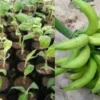- このトピックは空です。
- 投稿者投稿
- 3月 20, 2025 9:49 am #598207

Within the lush landscapes of Nigeria’s southeastern region, the Afang Leaf stands as a culinary cornerstone, a verdant vessel of flavor and nutrition.
This leafy green, scientifically known as Gnetum africanum, is more than just an ingredient; it’s a symbol of cultural heritage and culinary artistry, deeply intertwined with the traditions of the Efik and Ibibio people.
1. Culinary Significance and Preparation
Afang leaf is the star ingredient in the eponymous Afang soup, a rich and flavorful stew that’s a staple in Cross River and Akwa Ibom states.
The leaves are typically shredded or pounded before being added to the soup, where they release their unique aroma and slightly bitter taste.
The preparation of Afang soup is a communal activity, often involving family and friends, highlighting its social and cultural importance. The leaves are also used in other local dishes, showcasing their versatility.
2. Nutritional Profile and Health Benefits
Afang leaf is a nutritional powerhouse, rich in vitamins, minerals, and dietary fiber. It’s a good source of iron, calcium, and potassium, contributing to overall health and well-being. The high fiber content aids digestion and promotes gut health. Studies suggest that the leaf may also possess antioxidant and anti-inflammatory properties, offering potential health benefits. Its nutritional density makes it a valuable addition to the diet.
3. Cultural Symbolism and Traditional Uses
The Afang leaf holds significant cultural symbolism, often associated with celebrations and special occasions.
It’s a symbol of prosperity and abundance, reflecting the region’s agricultural wealth. Traditional healers also use the leaf for medicinal purposes, recognizing its therapeutic properties. Its use in traditional ceremonies reinforces its cultural significance.
4. Economic Importance and Local Markets
The demand for Afang leaf supports the livelihoods of many farmers and traders in southeastern Nigeria. It’s cultivated in home gardens and on commercial farms, providing a source of income for local communities.
The leaf is readily available in local markets, where it’s sold fresh or dried. Its economic contribution is vital for the region’s agricultural sector.
5. Challenges and Sustainability
Overharvesting and deforestation pose challenges to the sustainability of Afang leaf production. It’s crucial to promote sustainable harvesting practices and encourage cultivation to ensure its long-term availability.
Conservation efforts are needed to protect the natural habitats where the plant thrives. Educating communities on sustainable practices is essential for preserving this valuable resource.
The Afang Leaf is more than just a culinary ingredient; it’s a cultural treasure and a nutritional asset. Its role in traditional cuisine, its nutritional value, and its economic significance make it an integral part of the southeastern Nigerian landscape.
As challenges arise, sustainable practices are essential to ensure the continued enjoyment and benefits of this verdant vessel.
- 投稿者投稿
- このトピックに返信するにはログインが必要です。






